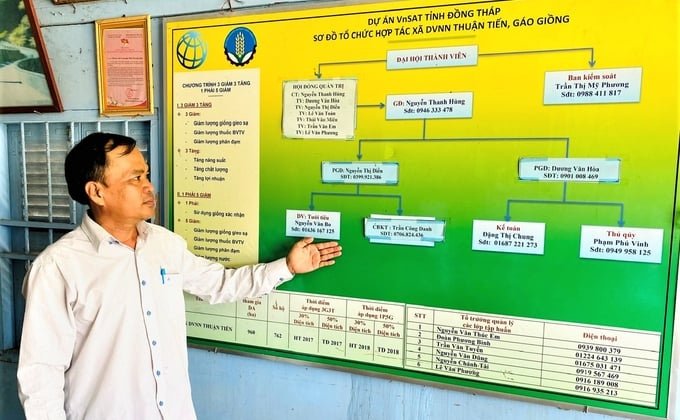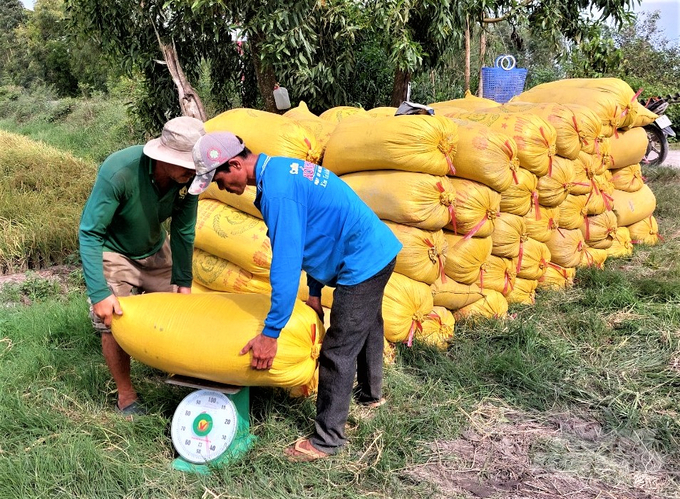November 24, 2025 | 10:39 GMT +7
November 24, 2025 | 10:39 GMT +7
Hotline: 0913.378.918
November 24, 2025 | 10:39 GMT +7
Hotline: 0913.378.918
Thuan Tien Agricultural Service Cooperative (Gao Giong commune, Cao Lanh district, Dong Thap province) has a total of 577 members, including 127 official members with a charter capital contribution of VND 3.6 billion to the cooperative, and 450 farmer households do not contribute capital but cooperate to use the Cooperative's services, including rice seeds, water pumping, fertilizer, land preparation, harvesting and consumption.
Mr. Nguyen Thanh Hung, Chairman of the Board of Directors and Director of Thuan Tien Agricultural Service Cooperative said that the Cooperative had implemented production links in a closed rice growing chain for more than 3 years with the participation of 577 members to produce and consume 2 production areas with a total area of 750 hectares growing rice 3 crops/year.

Dr. Tran Minh Hai (right), Vice Principal of the School of Public Policy and Rural Development, surveyed and supported Thuan Tien Cooperative within the framework of the project "Research and proposed solutions to build new-style agricultural cooperative models operating effectively in Dong Thap province." Photo: Trung Chanh.
To deploy the rice production chain, the cooperative often invites 3 businesses with many years of association to agree on a plan to link rice production and consumption for each crop of the year. Enterprises set rice quality standards for each production season from the beginning of the year, requiring certified seeds, recording production logs, and finishing fertilizing and spraying pesticides 30 days before harvest.
Enterprises advance 30% of production costs so that the cooperative can provide members with certified rice seeds, fertilizers, and pesticides. The contract price will be agreed upon 3 weeks before the rice harvest of each crop. Payment method: Enterprises pay through the cooperative, including 50% payment immediately upon closing and the remaining 50% payment 3 - 4 hours after the enterprise receives the rice.
The cooperative is responsible for organizing and providing services to businesses, including recording production logs, handling harvesting machines, loading and unloading workers, and transporting rice according to the harvest time agreed upon with the business. Enterprises will pay a service fee to the cooperative of VND 20/kg of paddy for the entire harvested output in the associated production area, equivalent to about VND 100 million/crop.

Mr. Nguyen Thanh Hung, Chairman of the Board of Directors and Director of Thuan Tien Agricultural Service Cooperative presented the operating model, production, and business direction using the "buy together, sell together" method that benefits cooperative members. Photo: Trung Chanh.
Based on the contract with each enterprise for all 3 production seasons/year, every year, the cooperative develops an annual production and business plan including services of joint purchase of rice seeds, joint purchase of fertilizers and pesticides, and organization of teams for tillage machines, spraying, harvesting, and internal credit.
In addition, the cooperative also applies digital technology through the Zalo group to announce and seek comments on the cooperative's annual production and business plan to people and commune officials. Because the annual business plan suits local conditions, it is presented for members and farmers in the linked chain to discuss and contribute ideas.
Therefore, the production cost of each household is low, and the production cost of cooperative member households is low. Still, the selling price in the cooperative area is often VND 800 - 1,100/kg higher than outside, so profits are much higher.
The cooperative invests in an improved water pumping system to save members 20 - 30% of water pumping costs. The cooperative and its members apply the alternating wet and dry irrigation method, which reduces water pumping twice compared to other areas and makes the ground hard, and the rice plants take deep roots.
Regarding output, the cooperative signed a contract with the enterprise. It sold the entire field right from the beginning of the season and received a deposit of 30% of the contract value from the enterprise. Cooperatives often provide members certified rice seeds and credit for all these deposits, so there is almost "no concept of rice brokers depositing to buy young paddy in the cooperative area."

Based on the contract with each enterprise for all 3 production seasons/year, Thuan Tien Cooperative will develop a production and business plan every year. When harvest occurs, the entire paddy in the field will be sold to the enterprise. Photo: Trung Chanh.
The cooperative is given a table of product standards, business requirements, and an advance payment from the business, so it is easy to manage production to ensure the best quality of rice for the business. The cooperative invites businesses and members to visit the fields three weeks before harvest, evaluate rice quality, estimate average rice yield, and finalize contract prices. Afterward, the cooperative leaders and the enterprise's people plan the harvest, monitor the harvesting machines, and purchase rice for members/farmers. Management, harvest monitoring, and rice weighing... are paid by the business at 20 VND/kg of paddy, creating additional operating funds for the cooperative.
Linking production as "buying together, selling together" has helped members and farmers associate with cooperatives to reduce investment costs, lower prices, and increase profits. Specifically, farmers in the linked chain enjoy higher profits of at least VND 500/kg of rice. With a rice yield of 6.5 - 7 tons/ha, the additional profit for cooperative members is not tiny, up to 3 - 3.5 million/ha. In addition, by jointly purchasing rice seeds and supplies as "Cooperatives buy for members," the production costs of members and farmers affiliated with the cooperative are saved at least VND 1.5 million/ha. Counting these amounts alone, members and farmers have a higher profit of VND 4.5 - 5 million/ha than single farmers outside the cooperative.
Translated by Tuan Huy
/2025/11/22/4018-4-213342_747.jpg)
(VAN) The Mekong Delta Agricultural Experts Club has attracted 143 experts and researchers to participate in providing consultancy and contributing initiatives to the development of one million hectares of high-quality rice.

(VAN) Ca Mau’s development of OCOP products opens a path to increasing cooperatives value, helping boost income, expand markets, and affirm collective economy's role.

(VAN) Turning seemingly ordinary coconut shells into unique jewelry and artwork, Nguyen Bang Nhi spreads the value of local culture through her brand, Cocohand.

(VAN) Results from the Sustainable Durian Model Project in Dak Lak have confirmed the critical role of Yara Viet Nam in transferring advanced nutritional solutions to farmers.

(VAN) In Tuyen Quang province, livestock farmers have introduced effective models and innovative practices that significantly strengthen African Swine Fever prevention and control efforts.

(VAN) This is the study conducted by IRRI and Can Tho University on the rice straw value chain in Mekong Delta showing an economic potential of more than 6.6 trillion VND/year.

(VAN) By participating in cooperative economics, many farmers in Tay Ninh have overcome hardship, mastered clean dragon fruit cultivation techniques.